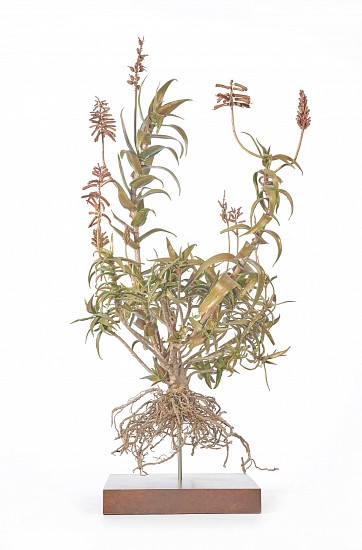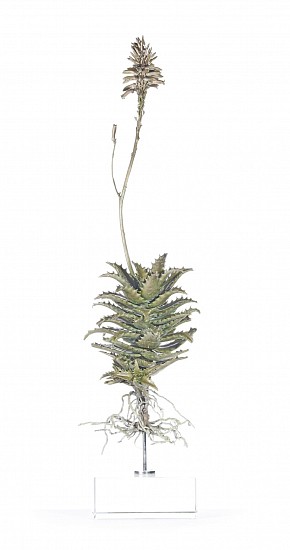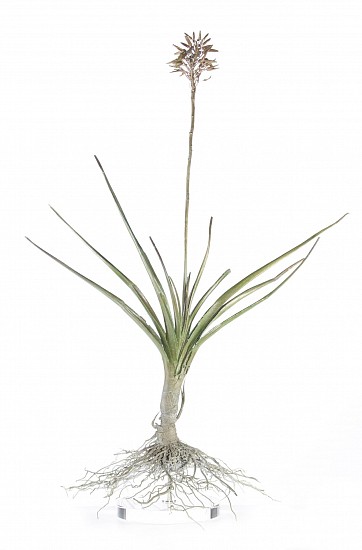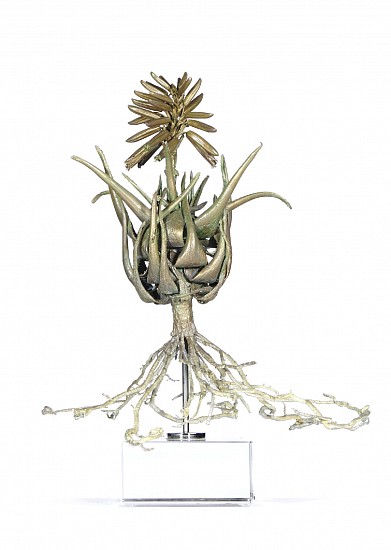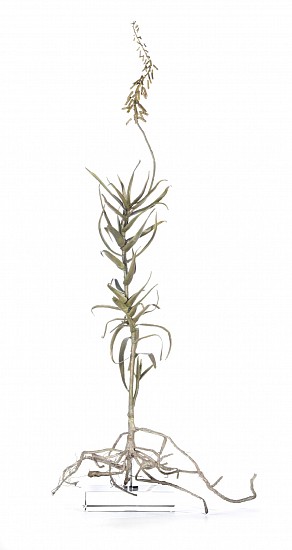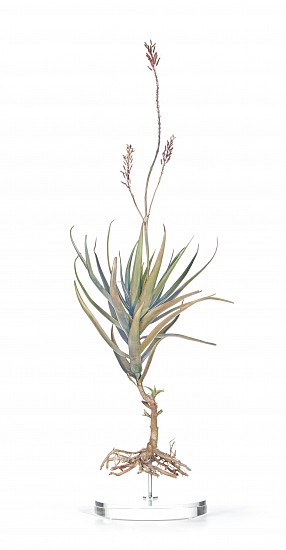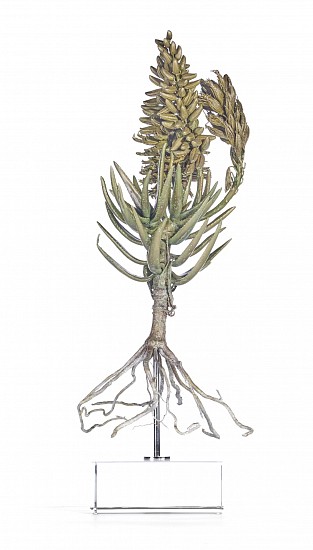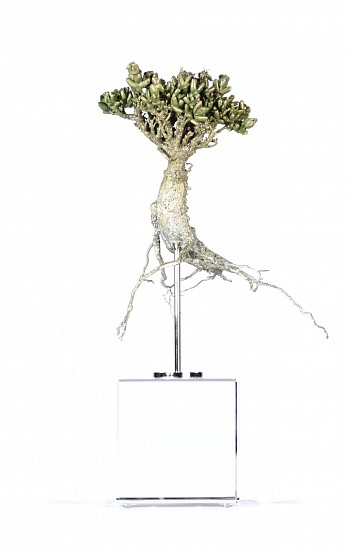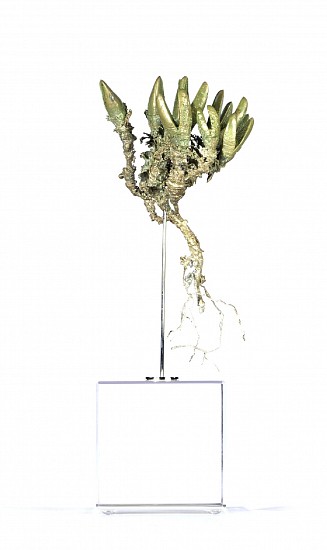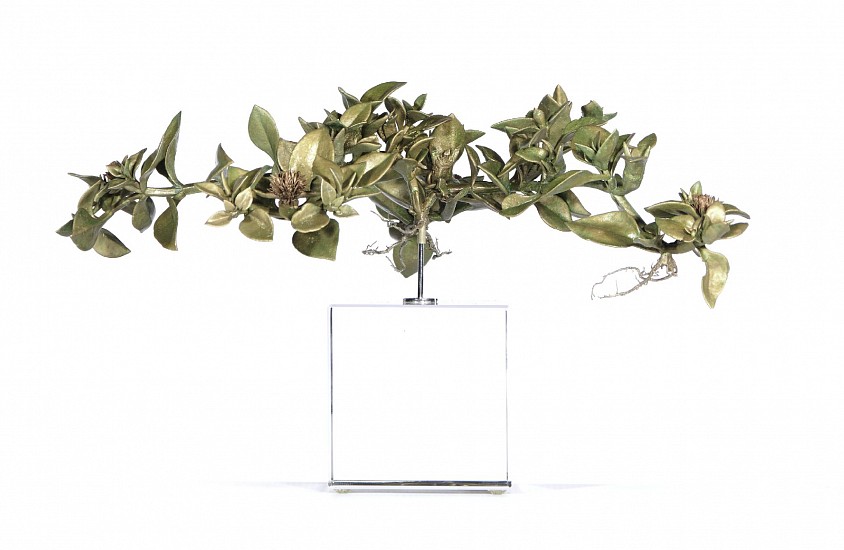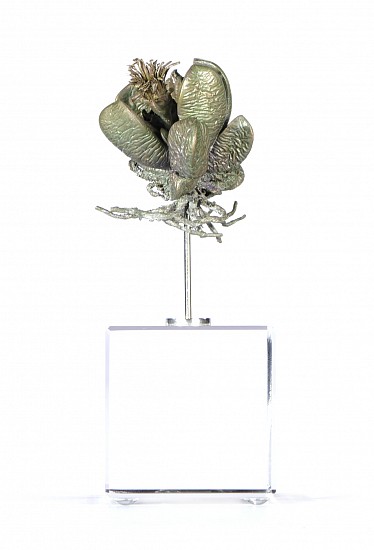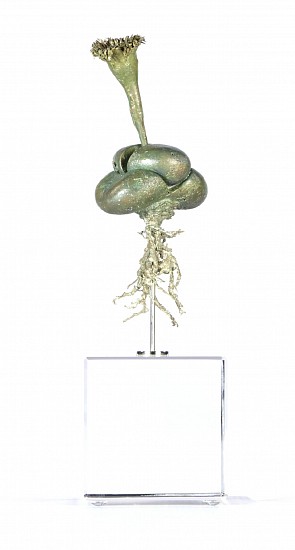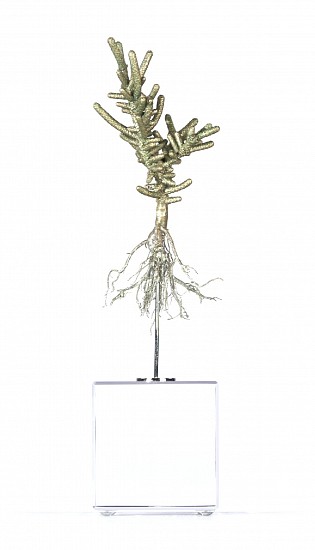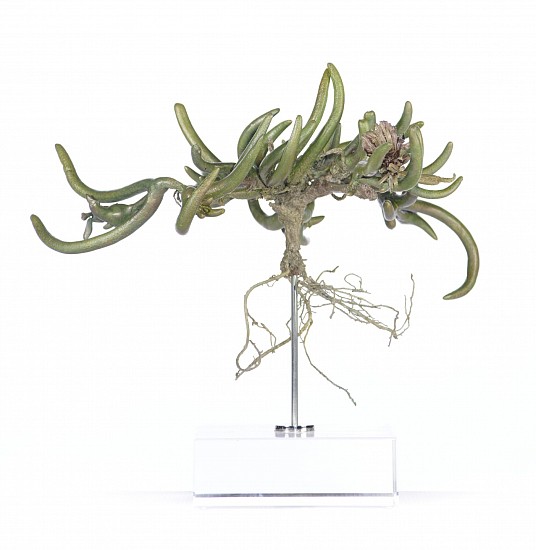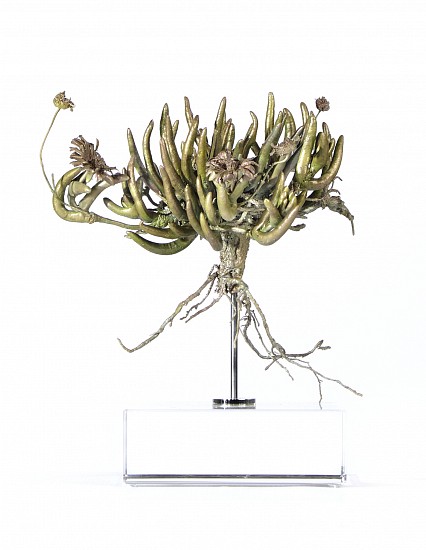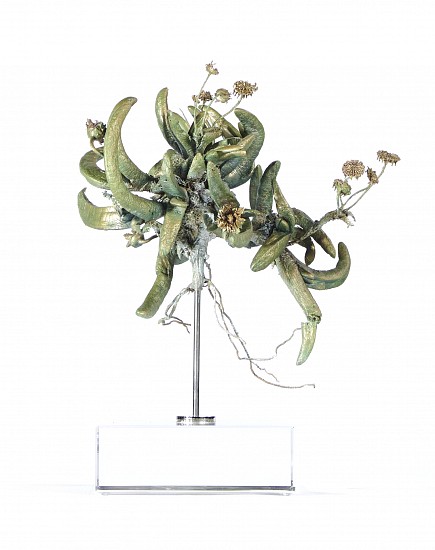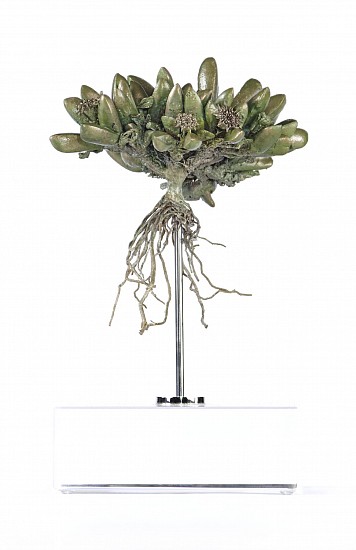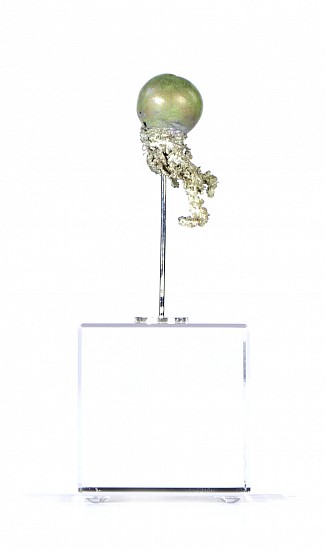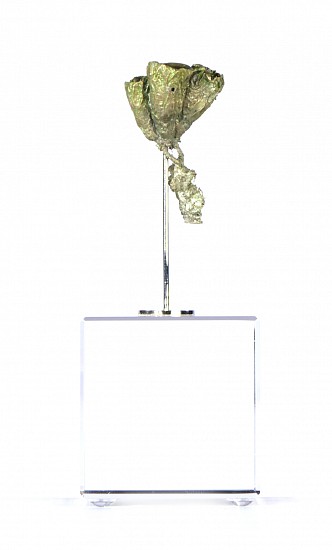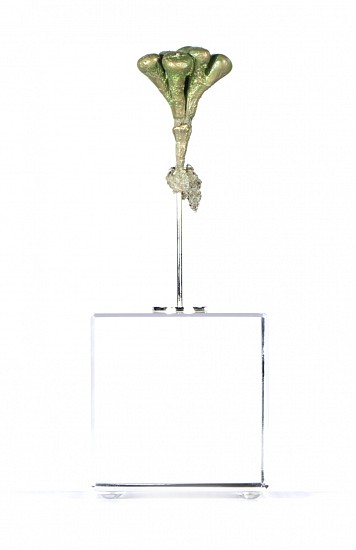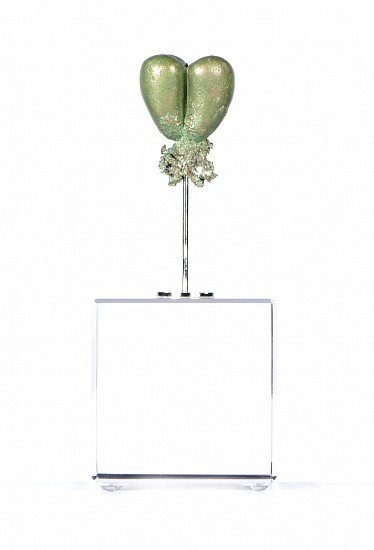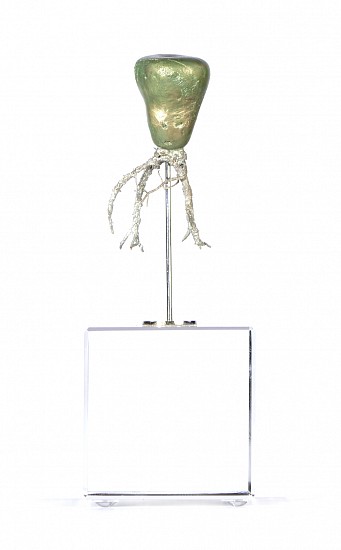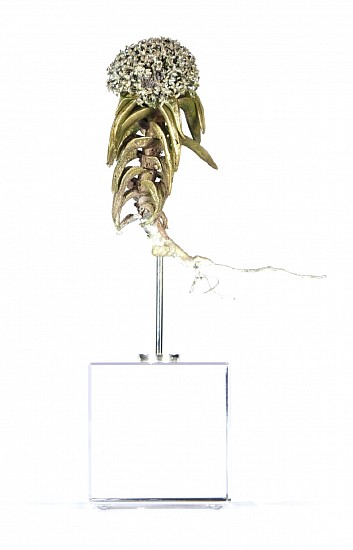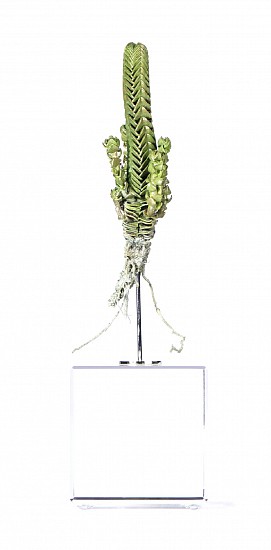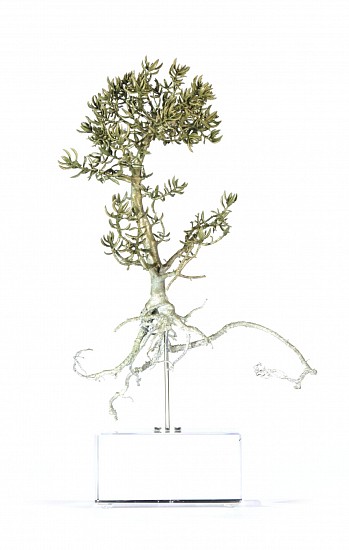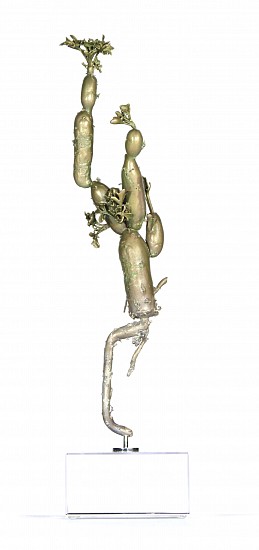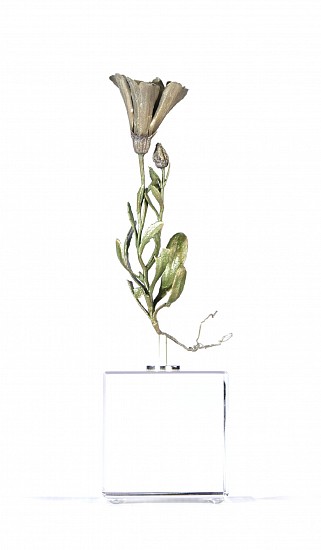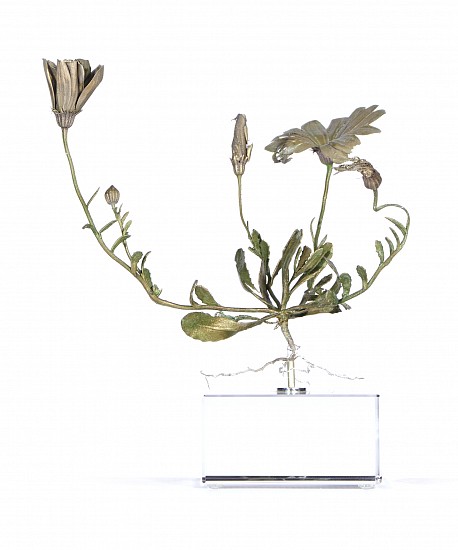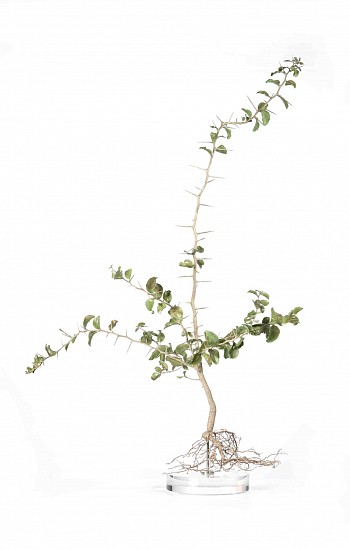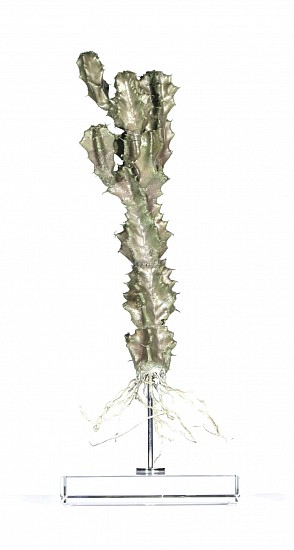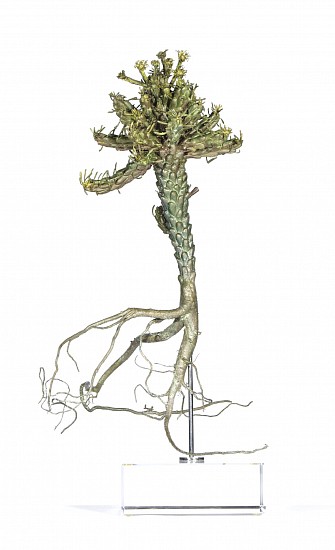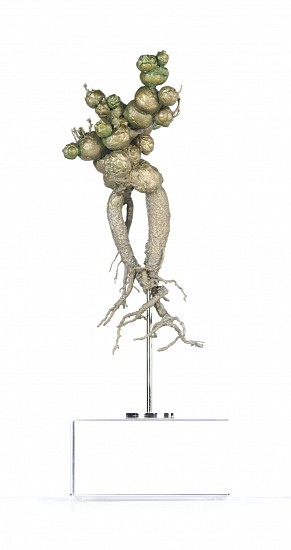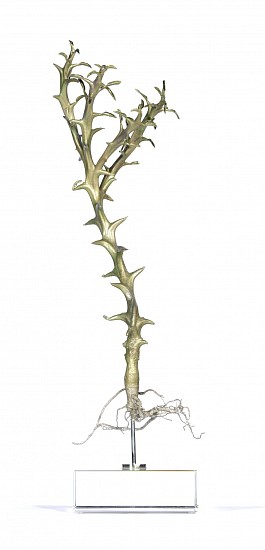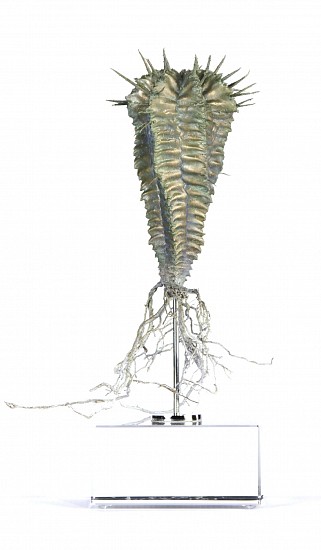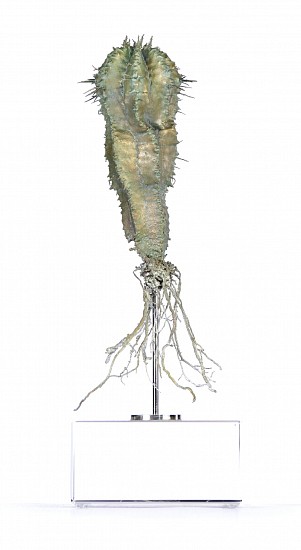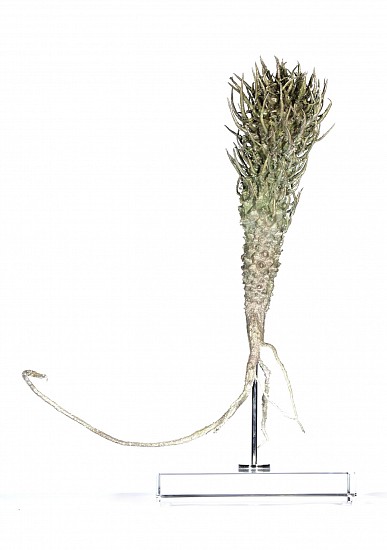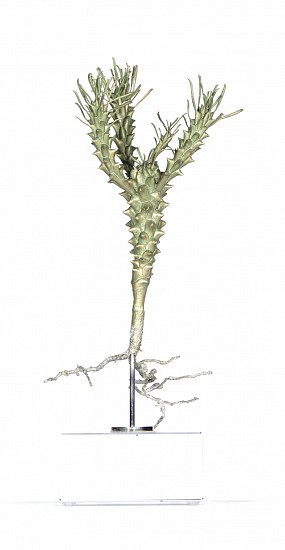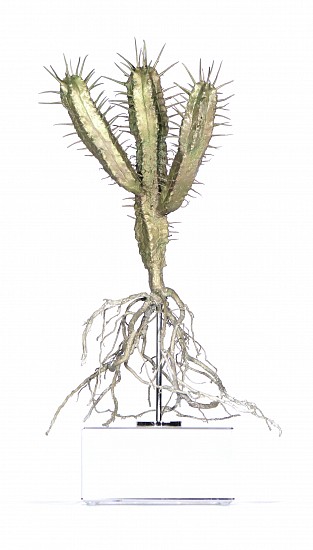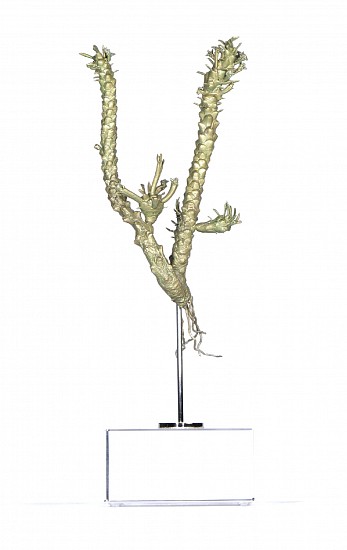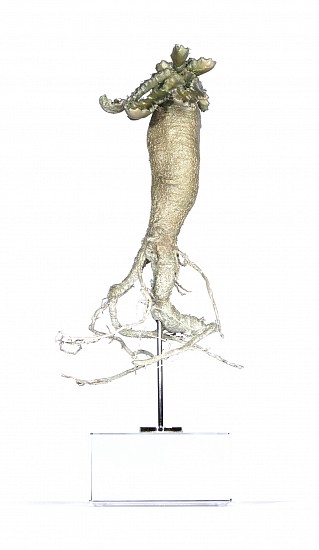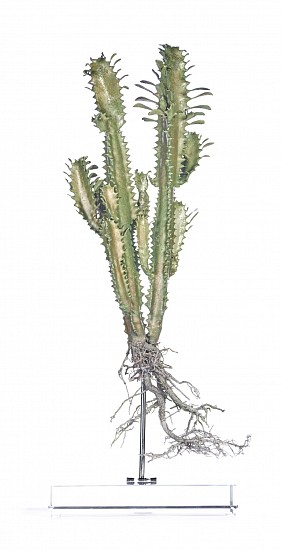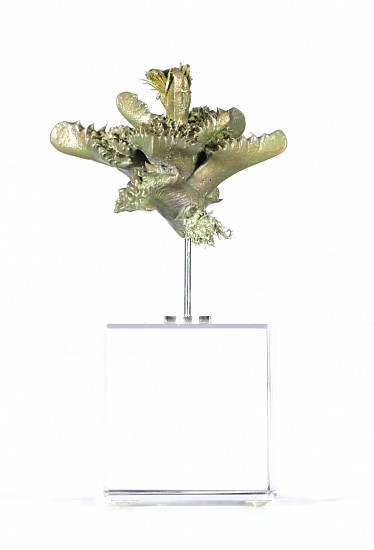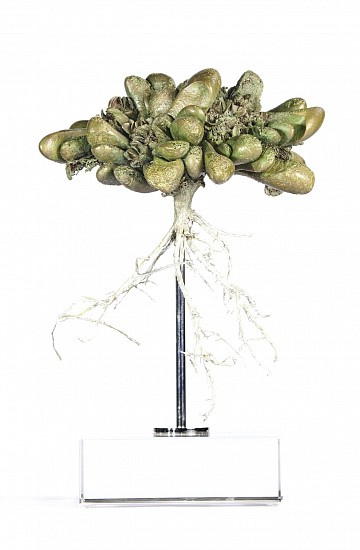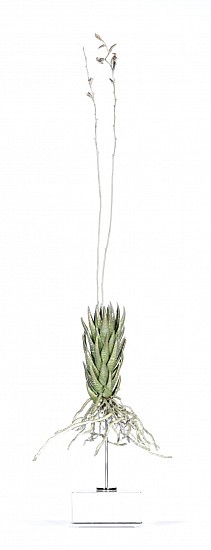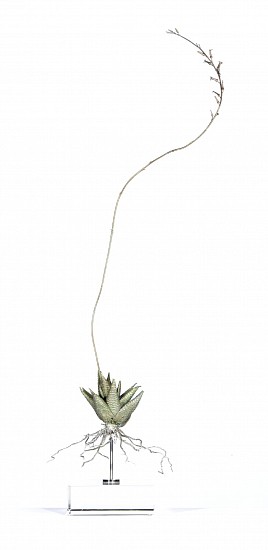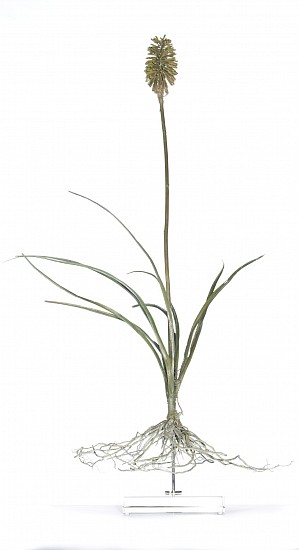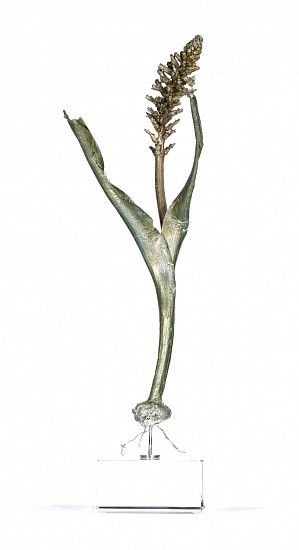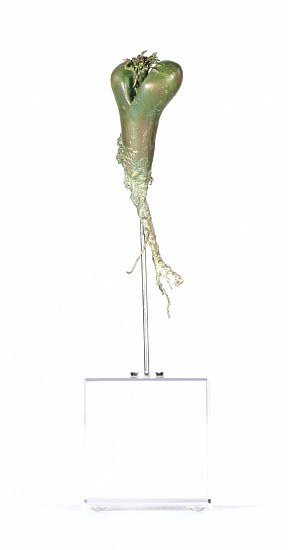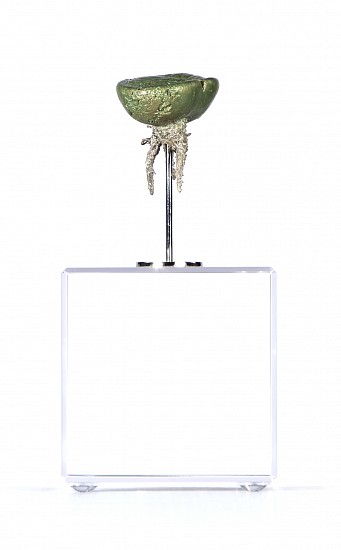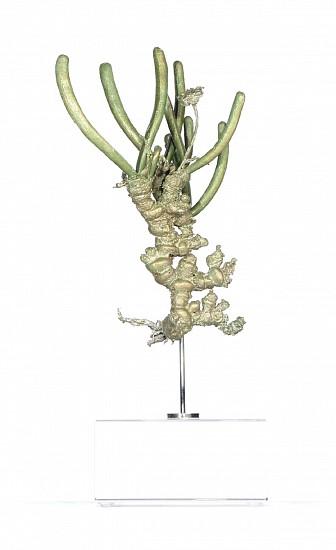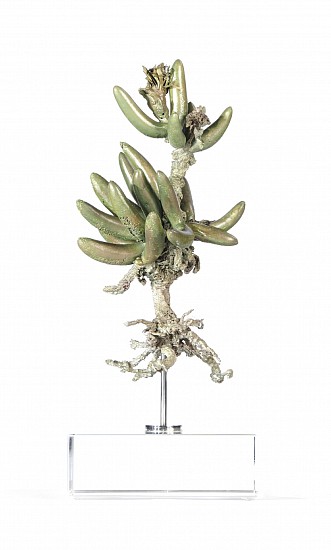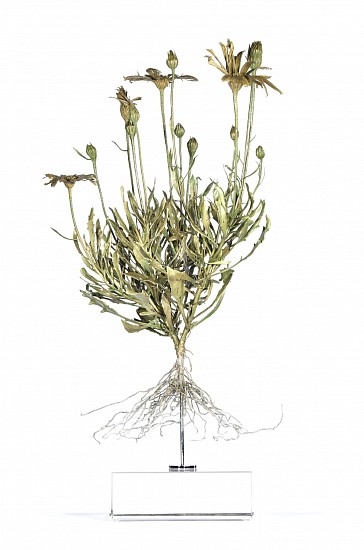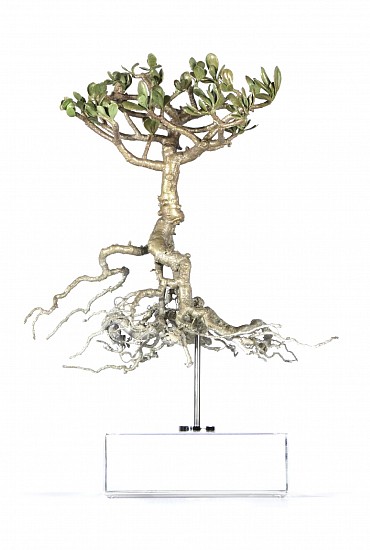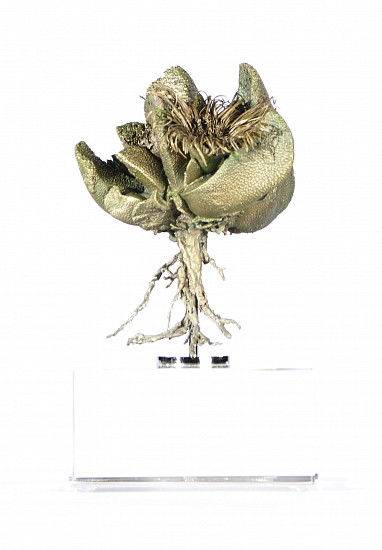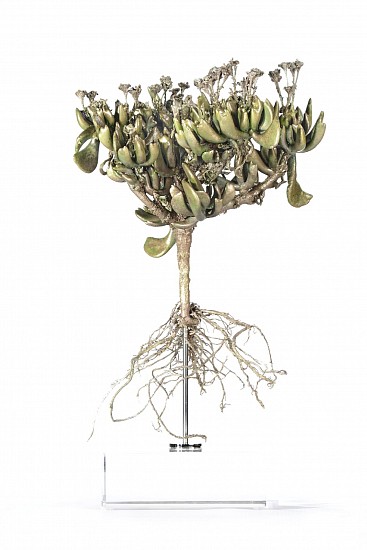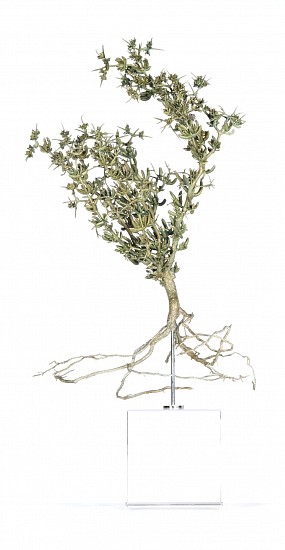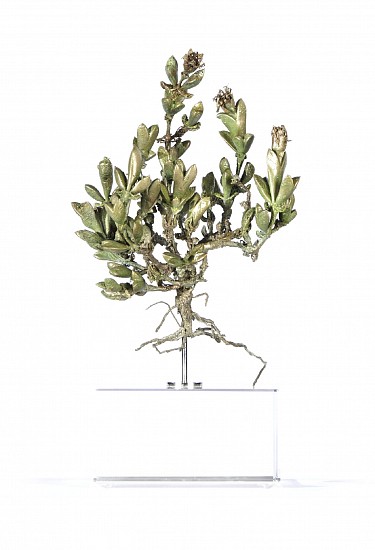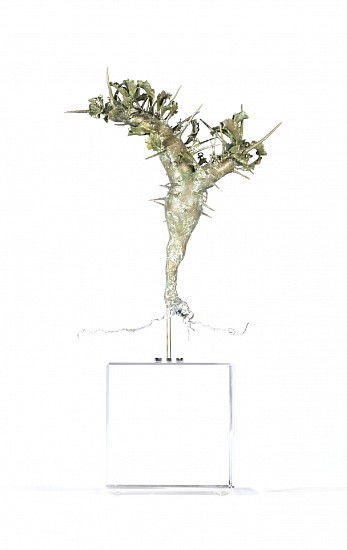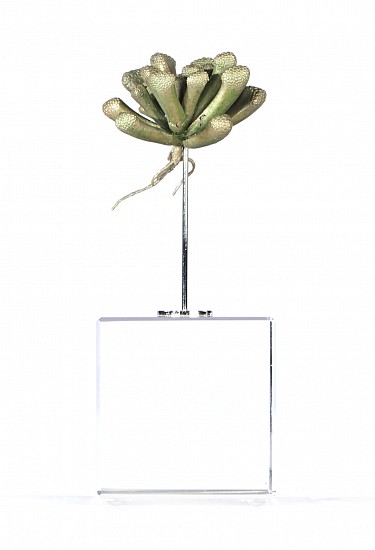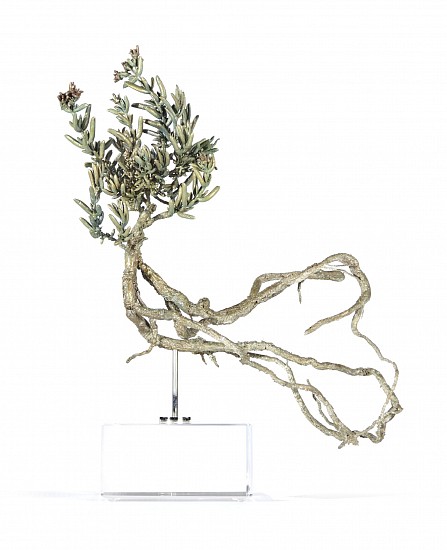NIC BLADEN | Hinterland: Botanical Explorations


NIC BLADEN, Aloe Ciliaris
Bronze on patinated mild steel base, 125 x 76 x 60 cm
South African artist Nic Bladen is one of the world's finest botanical sculptors working today. Bladen strives to record the subtle and diverse biodiversity of his native Western Cape by creating unique bronze sculptures using the actual plant matter. Drawing on the ancient traditions of the lost wax method, Bladen has pioneered a new technique which has allowed him to render the finest organic details of his subjects.
Aloiampelos ciliaris (formerly Aloe ciliaris), the common climbing-aloe, is a thin-leaved and generally rapidly-growing succulent plant from Southern Africa.


NIC BLADEN, Aloe congolensis
Bronze on crystal base, 76 x 20 x 20.5 cm
South African artist Nic Bladen is one of the world's finest botanical sculptors working today. Bladen strives to record the subtle and diverse biodiversity of his native Western Cape by creating unique bronze sculptures using the actual plant matter. Drawing on the ancient traditions of the lost wax method, Bladen has pioneered a new technique which has allowed him to render the finest organic details of his subjects.
This sculpture depicts the Aloe congolensis, native to the Congo and commonly known as 'Tiger tooth aloe'. If nurtured in its infancy and allowed to develop an established root system, this plant will flower with pink or red-orange flowers in late autumn to mid winter, atop an unbranched influroescence of 30cm or more.
| | Everard Read London


NIC BLADEN, Aloe cooperi
Bronze on crystal base, 118 x 44 x 98 cm
South African artist Nic Bladen is one of the world's finest botanical sculptors working today. Bladen strives to record the subtle and diverse biodiversity of his native Western Cape by creating unique bronze sculptures using the actual plant matter. Drawing on the ancient traditions of the lost wax method, Bladen has pioneered a new technique which has allowed him to render the finest organic details of his subjects.
This scultpure depicts the Aloe cooperi, a southern African grassland aloe which occurs mainly in Natal, Swaziland and Mpumalanga. The flowers of this plant vary in colour from greenish-cream to apricot and salmon pink; these flowers and the young shoots of the plant are often cooked and eaten as vegetables by the Zulu people.
| | Everard Read London


NIC BLADEN, Aloe krapohliana
Bronze on crystal base, 27 x 18.5 x 19.5 cm
South African artist Nic Bladen is one of the world's finest botanical sculptors working today. Bladen strives to record the subtle and diverse biodiversity of his native Western Cape by creating unique bronze sculptures using the actual plant matter. Drawing on the ancient traditions of the lost wax method, Bladen has pioneered a new technique which has allowed him to render the finest organic details of his subjects.
This sculpture depicts the Aloe krapohliana, a dwarf aloe which reaches a height of no more than 250mm. In spite of its diminutive size, the Aloe krapohliana can grow up to 6 inflorescence from a single rosette, making them one of the most floriferous plants of all aloes. This succulent is also classified as 'Data Deficient' due to overcollecting, overgrazing and habitat destruction, particularly as it occurs in areas which are heavily mined.
| | Everard Read London
NIC BLADEN, Aloiampelos tenuior (i)
Bronze on crystal base, 106 x 38 x 39 cm
South African artist Nic Bladen is one of the world's finest botanical sculptors working today. Bladen strives to record the subtle and diverse biodiversity of his native Western Cape by creating unique bronze sculptures using the actual plant matter. Drawing on the ancient traditions of the lost wax method, Bladen has pioneered a new technique which has allowed him to render the finest organic details of his subjects.
This sculpture depicts the Aloiampelos tenuior, coloquially known as 'Fence aloe', or 'Slender aloe'. This rambling aloe forms large clumps topped with masses of delicate, yellow or red flowerheads in the summer. The 2014 study by Duffy, Johnson and Peter, showed that Aloiampelos tenuior requires a pollinator in order to set seed; its most frequent visitors are honeybees and butterflies. At Kirstenbosch, which is well outside of its natural range, honeybees, various beetles and the local sunbirds are seen feeding on the flowers.



NIC BLADEN, Aloiampelos tenuior (ii)
Bronze on crystal base, 83 x 34.5 x 34.5 cm
South African artist Nic Bladen is one of the world's finest botanical sculptors working today. Bladen strives to record the subtle and diverse biodiversity of his native Western Cape by creating unique bronze sculptures using the actual plant matter. Drawing on the ancient traditions of the lost wax method, Bladen has pioneered a new technique which has allowed him to render the finest organic details of his subjects.
This sculpture depicts the Aloiampelos tenuior, coloquially known as 'Fence aloe', or 'Slender aloe'. This rambling aloe forms large clumps topped with masses of delicate, yellow or red flowerheads in the summer. The 2014 study by Duffy, Johnson and Peter, showed that Aloiampelos tenuior requires a pollinator in order to set seed; its most frequent visitors are honeybees and butterflies. At Kirstenbosch, which is well outside of its natural range, honeybees, various beetles and the local sunbirds are seen feeding on the flowers.



NIC BLADEN, Aloidendron dichotomum (i)
Bronze on crystal base, 61.5 x 24.5 x 26 cm
South African artist Nic Bladen is one of the world's finest botanical sculptors working today. Bladen strives to record the subtle and diverse biodiversity of his native Western Cape by creating unique bronze sculptures using the actual plant matter. Drawing on the ancient traditions of the lost wax method, Bladen has pioneered a new technique which has allowed him to render the finest organic details of his subjects.
This sculpture depicts the Aloidendron dichotomum, colloquially referred to as 'Quiver tree'. It is probably the best known aloe found in South Africa and Namibia. This tree aloe has smooth branches, which are covered with a thin layer of whitish powder that helps to reflect away the hot sun's rays. Indeed, large trunks of dead trees can be hollowed out and used as a 'natural fridge' to store water, meat and vegetables. An extremely tough tree, the Aloidendron dichotomum may reach an age of over 80 years and a height of over 7 metres. The bark on the trunk forms razor sharp scales, and the branches of these trees are commonly home to communal weaver nests.
| | Everard Read London
NIC BLADEN, Antimima pygmaea
Bronze on crystal base, 16 x 8.5 x 13 cm
South African artist Nic Bladen is one of the world's finest botanical sculptors working today. Bladen strives to record the subtle and diverse biodiversity of his native Western Cape by creating unique bronze sculptures using the actual plant matter. Drawing on the ancient traditions of the lost wax method, Bladen has pioneered a new technique which has allowed him to render the finest organic details of his subjects.
Antimima pygmaea, colloquially known as Witkranzvygiehe, is a sucullent native to South Africa and produces only two pairs of leaves each year on each branch.
| | Everard Read London



NIC BLADEN, Antimima ventricosa
Bronze on crystal base, 20 x 6 x 7 cm
South African artist Nic Bladen is one of the world's finest botanical sculptors working today. Bladen strives to record the subtle and diverse biodiversity of his native Western Cape by creating unique bronze sculptures using the actual plant matter. Drawing on the ancient traditions of the lost wax method, Bladen has pioneered a new technique which has allowed him to render the finest organic details of his subjects.
The Antimima ventricosa, colloquially known as Lutzvillevygie, is a stable species originating in the Western Cape, growing on slopes with quartzite stones. A small succulent shrub, this plant forms a compact cushion and bears large, daisy-like mauve flowers.



NIC BLADEN, Aptenia cordifolia
Bronze on crystal base, 18 x 29 x 32 cm
South African artist Nic Bladen is one of the finest botanical sculptors working today. Bladen strives to record the subtle and diverse biodiversity of his native Western Cape by creating unique bronze sculptures using the actual plant matter. Drawing on the ancient traditions of the lost wax method, Bladen has pioneered a new technique which has allowed him to render the finest organic details of his subjects.
Aptenia cordifolia, colloquially known as Rooibrakvygie or baby sun rose, is an evergreen and fast-growing succulent, often a short-lived perennial, 250 mm high. Its flowers are purple to red, opening in the brightest hours of the day from noon to the early afternoon. Aptenia cordifolia is used medicinally as an anti-inflammatory and a poultice, but also as a love and good luck charm.
| | Everard Read London


NIC BLADEN, Argyroderma patens
Bronze on crystal base, 13 x 5 x 6.5 cm
South African artist Nic Bladen is one of the world's finest botanical sculptors working today. Bladen strives to record the subtle and diverse biodiversity of his native Western Cape by creating unique bronze sculptures using the actual plant matter. Drawing on the ancient traditions of the lost wax method, Bladen has pioneered a new technique which has allowed him to render the finest organic details of his subjects.
The genus Argyroderma is restricted to the Knersvlatke area in southern Namaqualand in the northwestern part of the Western Cape Province, South Africa. They are compact, dwarf succulents, tufted or single-bodied, and rarely sunken in the ground. The highly succulent leaf pairs are rounded or thumb-shaped and in pairs united at the base. The characteristic silvery green leaves are smooth. The plants are extremely popular among collectors.


NIC BLADEN, Argyroderma sp.
Bronze on crystal base, 20 x 6 x 6 cm
South African artist Nic Bladen is one of the world's finest botanical sculptors working today. Bladen strives to record the subtle and diverse biodiversity of his native Western Cape by creating unique bronze sculptures using the actual plant matter. Drawing on the ancient traditions of the lost wax method, Bladen has pioneered a new technique which has allowed him to render the finest organic details of his subjects.
The genus Argyroderma is restricted to the Knersvlatke area in southern Namaqualand in the northwestern part of the Western Cape Province, South Africa. They are compact, dwarf succulents, tufted or single-bodied, and rarely sunken in the ground. The highly succulent leaf pairs are rounded or thumb-shaped and in pairs united at the base. The characteristic silvery green leaves are smooth. The plants are extremely popular among collectors.


NIC BLADEN, Avonia ustulata
Bronze on crystal base, 18.5 x 5 x 5.3 cm
South African artist Nic Bladen is one of the world's finest botanical sculptors working today. Bladen strives to record the subtle and diverse biodiversity of his native Western Cape by creating unique bronze sculptures using the actual plant matter. Drawing on the ancient traditions of the lost wax method, Bladen has pioneered a new technique which has allowed him to render the finest organic details of his subjects.
Avonia ustulate, colloquially known as Moerbossie or Kieriemoer, grows on grey or yellowish shales of the Karoo, and is coloured to blend with the background.
| | Everard Read London



NIC BLADEN, Cephalophyllum alstonii
Bronze on crystal base, 26.5 x 26 x 28.5 cm
South African artist Nic Bladen is one of the world's finest botanical sculptors working today. Bladen strives to record the subtle and diverse biodiversity of his native Western Cape by creating unique bronze sculptures using the actual plant matter. Drawing on the ancient traditions of the lost wax method, Bladen has pioneered a new technique which has allowed him to render the finest organic details of his subjects.
Cephallophyllum alstonii is a creeping perennial succulent, whose spectacular, brightly coloured blood-red flowers attract insects when the flowers open.



NIC BLADEN, Cephalophyllum pulchrum
Bronze on crystal base, 21.5 x 21 x 26 cm
South African artist Nic Bladen is one of the world's finest botanical sculptors working today. Bladen strives to record the subtle and diverse biodiversity of his native Western Cape by creating unique bronze sculptures using the actual plant matter. Drawing on the ancient traditions of the lost wax method, Bladen has pioneered a new technique which has allowed him to render the finest organic details of his subjects.
Colloquially known as Persvygie, Cephalophyllum pulchrum is a dwarf succulent from South Africa, with small carpets of erect, finger-like, grey-green, cylindrical leaves. The plant produces pretty, beautiful purple-pink flowers.
| | Everard Read London



NIC BLADEN, Cephalophyllum spissum
Bronze on crystal base, 25.6 x 18 x 19.2 cm
South African artist Nic Bladen is one of the world's finest botanical sculptors working today. Bladen strives to record the subtle and diverse biodiversity of his native Western Cape by creating unique bronze sculptures using the actual plant matter. Drawing on the ancient traditions of the lost wax method, Bladen has pioneered a new technique which has allowed him to render the finest organic details of his subjects.
Colloquially known as Skaapvygie, Cephalophyllum spissum is a small succulent endemic to the Western Cape.t blooms twice a year with showy flowers nearly 4 cm across, displaying unusual salmon-rose coloured silky-rayed petals and a showy white centre with colourful anthers.
| | Everard Read London


NIC BLADEN, Cheiridopsis purpurea
Bronze on crystal base, 21.5 x 12 x 14 cm
South African artist Nic Bladen is one of the world's finest botanical sculptors working today. Bladen strives to record the subtle and diverse biodiversity of his native Western Cape by creating unique bronze sculptures using the actual plant matter. Drawing on the ancient traditions of the lost wax method, Bladen has pioneered a new technique which has allowed him to render the finest organic details of his subjects.
Colloquially known as Hasieore, Cheiridopsis purpurea is a small tufted succulent that, when mature, forms large clumps or dwarf shrublets.
| | Everard Read London


NIC BLADEN, Conophytum calculus
Bronze on crystal base, 12.5 x 5 x 5 cm
South African artist Nic Bladen is one of the world's finest botanical sculptors working today. Bladen strives to record the subtle and diverse biodiversity of his native Western Cape by creating unique bronze sculptures using the actual plant matter. Drawing on the ancient traditions of the lost wax method, Bladen has pioneered a new technique which has allowed him to render the finest organic details of his subjects.
Conophytum calculus, colloquially known as knopies (buttons) or toontjies (little toes), are humorous-looking `pebble plants' with unusual night-time opening flowers which have a delightfully spicy scent.
| | Everard Read London


NIC BLADEN, Conophytum doscurum-sponsalbrum
Bronze on crystal base, 12.5 x 5 x 5 cm
South African artist Nic Bladen is one of the world's finest botanical sculptors working today. Bladen strives to record the subtle and diverse biodiversity of his native Western Cape by creating unique bronze sculptures using the actual plant matter. Drawing on the ancient traditions of the lost wax method, Bladen has pioneered a new technique which has allowed him to render the finest organic details of his subjects.
Conophytum is a genus of South African and Namibian succulent plants that belong to the family Aizoaceae. The name is derived from the Latin conus (cone) and Greek phytum (plant). The plants are also known as knopies (buttons in Afrikaans), waterblasies (water blisters in Afrikaans), sphaeroids, conos, cone plants, dumplings, or button plants.
| | Everard Read London


NIC BLADEN, Conophytum putchellum
Bronze on crystal base, 13 x 5 x 5 cm
South African artist Nic Bladen is one of the world's finest botanical sculptors working today. Bladen strives to record the subtle and diverse biodiversity of his native Western Cape by creating unique bronze sculptures using the actual plant matter. Drawing on the ancient traditions of the lost wax method, Bladen has pioneered a new technique which has allowed him to render the finest organic details of his subjects.
Conophytum is a genus of South African and Namibian succulent plants that belong to the family Aizoaceae. The name is derived from the Latin conus (cone) and Greek phytum (plant). The plants are also known as knopies (buttons in Afrikaans), waterblasies (water blisters in Afrikaans), sphaeroids, conos, cone plants, dumplings, or button plants.
| | Everard Read London


NIC BLADEN, Conophytum rotem-namies
Bronze on crystal base, 12 x 5 x 5 cm
South African artist Nic Bladen is one of the world's finest botanical sculptors working today. Bladen strives to record the subtle and diverse biodiversity of his native Western Cape by creating unique bronze sculptures using the actual plant matter. Drawing on the ancient traditions of the lost wax method, Bladen has pioneered a new technique which has allowed him to render the finest organic details of his subjects.
Conophytum is a genus of South African and Namibian succulent plants that belong to the family Aizoaceae. The name is derived from the Latin conus (cone) and Greek phytum (plant). The plants are also known as knopies (buttons in Afrikaans), waterblasies (water blisters in Afrikaans), sphaeroids, conos, cone plants, dumplings, or button plants.
| | Everard Read London


NIC BLADEN, Conophytum sp.
Bronze on crystal base, 13 x 5 x 5 cm
South African artist Nic Bladen is one of the world's finest botanical sculptors working today. Bladen strives to record the subtle and diverse biodiversity of his native Western Cape by creating unique bronze sculptures using the actual plant matter. Drawing on the ancient traditions of the lost wax method, Bladen has pioneered a new technique which has allowed him to render the finest organic details of his subjects.
Conophytum is a genus of South African and Namibian succulent plants that belong to the family Aizoaceae. The name is derived from the Latin conus (cone) and Greek phytum (plant). The plants are also known as knopies (buttons in Afrikaans), waterblasies (water blisters in Afrikaans), sphaeroids, conos, cone plants, dumplings, or button plants.
| | Everard Read London


NIC BLADEN, Crassula congesta
Bronze on crystal base, 20 x 7 x 10 cm
South African artist Nic Bladen is one of the world's finest botanical sculptors working today. Bladen strives to record the subtle and diverse biodiversity of his native Western Cape by creating unique bronze sculptures using the actual plant matter. Drawing on the ancient traditions of the lost wax method, Bladen has pioneered a new technique which has allowed him to render the finest organic details of his subjects.
Crassula congesta is a dwarf monocarpic biennial succulent, meaning that it usually lives for only two years in the wild and dies after producing its sweet-smelling flowers.
| | Everard Read London


NIC BLADEN, Crassula pyramidalis
Bronze on crystal base, 18.5 x 5 x 5 cm
South African artist Nic Bladen is one of the world's finest botanical sculptors working today. Bladen strives to record the subtle and diverse biodiversity of his native Western Cape by creating unique bronze sculptures using the actual plant matter. Drawing on the ancient traditions of the lost wax method, Bladen has pioneered a new technique which has allowed him to render the finest organic details of his subjects.
Crassula pyramidalis, colloquially known as Koesnaatjie or Rygbossie, is found in the succulent Karoo, on coastal plains, dry Fynbos and hill-tops on quartzitic sand stone pavement, either in summer or winter rainfall areas.
| | Everard Read London


NIC BLADEN, Crassula tetragona
Bronze on crystal base, 25 x 11.5 x 14 cm
South African artist Nic Bladen is one of the world's finest botanical sculptors working today. Bladen strives to record the subtle and diverse biodiversity of his native Western Cape by creating unique bronze sculptures using the actual plant matter. Drawing on the ancient traditions of the lost wax method, Bladen has pioneered a new technique which has allowed him to render the finest organic details of his subjects.
Crassula tetragona was one of the earliest of the succulents to be cultivated in Europe, described by Linnaeus in 1753. It has woody stems with brown bark, with crossed pairs of leaves. It is found nearly in every succulent garden.
| | Everard Read London



NIC BLADEN, Curio articulatus
Bronze on crystal base, 32 x 8 x 8 cm
South African artist Nic Bladen is one of the world's finest botanical sculptors working today. Bladen strives to record the subtle and diverse biodiversity of his native Western Cape by creating unique bronze sculptures using the actual plant matter. Drawing on the ancient traditions of the lost wax method, Bladen has pioneered a new technique which has allowed him to render the finest organic details of his subjects.
Curio articulates, known commonly as Candle Plant or Hot Dog Cactus, is a deciduous succulent species that forms a somewhat sprawling clump 22-40 cm high by 30 cm or more wide and spreads by tubers which form an underground scaffolding, an anchoring system.
| | Everard Read London


NIC BLADEN, Dimorphetheca pluvialis (i)
Bronze on crystal base, 17 x 5 x 6 cm
South African artist Nic Bladen is one of the world's finest botanical sculptors working today. Bladen strives to record the subtle and diverse biodiversity of his native Western Cape by creating unique bronze sculptures using the actual plant matter. Drawing on the ancient traditions of the lost wax method, Bladen has pioneered a new technique which has allowed him to render the finest organic details of his subjects.
Dimorphotheca pluvialis, also know as Rain Daisy, Cape Daisy, Reenblommetjie or Namaqualand daisy, forms a bushy plant that is covered with large white daisies all flowering at the same level.
| | Everard Read London


NIC BLADEN, Dimorphetheca pluvialis (ii)
Bronze on crystal base, 19.8 x 18 x 19.4 cm
South African artist Nic Bladen is one of the world's finest botanical sculptors working today. Bladen strives to record the subtle and diverse biodiversity of his native Western Cape by creating unique bronze sculptures using the actual plant matter. Drawing on the ancient traditions of the lost wax method, Bladen has pioneered a new technique which has allowed him to render the finest organic details of his subjects.
Dimorphotheca pluvialis, also know as Rain Daisy, Cape Daisy, Reenblommetjie or Namaqualand daisy, forms a bushy plant that is covered with large white daisies all flowering at the same level.
| | Everard Read London


NIC BLADEN, Dovyalis Caffra (""Kei Apple""
Bronze on crystal base, 125 x 85 x 73 cm
Nic Bladen is regarded as one of the world’s finest botanical sculptors working today. Through
the alchemical process that transpires in his studio’s furnaces, he can produce delicate artistic
reconstructions of astoundingly beautiful flowering plants.
The precision and care that goes into casting and reconstructing lifelike replicas is immense, and Bladen has become a master of his craft. Central to Bladen’s mission is a desire to preserve the singular beauty of plants, and through his sculptures (all unique casts) the artist shines a light on the subtle and diverse beauty of the plants of his native Western Cape. We are more sensitized to their extraordinary beauty given the indications that their home is within a region that is profoundly affected by climate change.



NIC BLADEN, Euphorbia caerulescens
Bronze on crystal base, 52.3 x 20 x 26 cm
South African artist Nic Bladen is one of the world's finest botanical sculptors working today. Bladen strives to record the subtle and diverse biodiversity of his native Western Cape by creating unique bronze sculptures using the actual plant matter. Drawing on the ancient traditions of the lost wax method, Bladen has pioneered a new technique which has allowed him to render the finest organic details of his subjects.
Euphorbia caerulescens, colloquially known as Wolfsmelk, occurs on rocky outcrops mostly on northern slopes of hills and mountains, occasionally found on hilltops and in other habitats. It is often the dominant or sub-dominant species of much of the vegetation which practically covers large tracts of country.
| | Everard Read London



NIC BLADEN, Euphorbia caput-medusaea
Bronze on crystal base, 38.5 x 19 x 20 cm
South African artist Nic Bladen is one of the world's finest botanical sculptors working today. Bladen strives to record the subtle and diverse biodiversity of his native Western Cape by creating unique bronze sculptures using the actual plant matter. Drawing on the ancient traditions of the lost wax method, Bladen has pioneered a new technique which has allowed him to render the finest organic details of his subjects.
Euphorbia caput-medusae is a sprawling, succulent shrub that resembles the head of Medusa, with a rosette of narrow, serpent-like stems arising from a short, central caudex. The whole plant sometimes exceed 1 metre in diameter, but more frequently is about 40-70 cm wide. Look down into a large specimen, you'll see what looks like a sun flower and an example of a Fibonacci spiral.



NIC BLADEN, Euphorbia globosa
Bronze on crystal base, 22.5 x 8 x 9 cm
South African artist Nic Bladen is one of the world's finest botanical sculptors working today. Bladen strives to record the subtle and diverse biodiversity of his native Western Cape by creating unique bronze sculptures using the actual plant matter. Drawing on the ancient traditions of the lost wax method, Bladen has pioneered a new technique which has allowed him to render the finest organic details of his subjects.
The Eastern Cape Province is home to the charming and spineless Euphorbia globosa, colloquially known as Eierpol or Knopmelkbol. This dwarf succulent, from a near distance, appears as an arrangement of green, scaly marbles supported by brown-grey marbles underneath. The top spherical bodies are topped with a stalked crown, from which flowering occurs and to which another marble-like body is added. This results in a fairly spread cluster of balls, and when cultivated, makes a beautiful potted plant.
| | Everard Read London



NIC BLADEN, Euphorbia gorgonis
Bronze on crystal base, 18 x 13 x 14 cm
South African artist Nic Bladen is one of the world's finest botanical sculptors working today. Bladen strives to record the subtle and diverse biodiversity of his native Western Cape by creating unique bronze sculptures using the actual plant matter. Drawing on the ancient traditions of the lost wax method, Bladen has pioneered a new technique which has allowed him to render the finest organic details of his subjects.
Euphorbia gorgonis, colloquially known as Melkbol or Slanggif, is a spineless, small growing, species of the 'medusa head' type of euphorbia. It has a deep tap root that merge into a broad subglobose main stem (caudex), which bears a compact crown of short radiating branches in 3–5 series around a branchless flat or depressed central area. It is a choice species, much prized by collectors because of its symmetrical form and neat habit.
| | Everard Read London


NIC BLADEN, Euphorbia hamata
Bronze on crystal base, 47.3 x 14.5 x 15 cm
South African artist Nic Bladen is one of the world's finest botanical sculptors working today. Bladen strives to record the subtle and diverse biodiversity of his native Western Cape by creating unique bronze sculptures using the actual plant matter. Drawing on the ancient traditions of the lost wax method, Bladen has pioneered a new technique which has allowed him to render the finest organic details of his subjects.
Euphorbia hamata, colloquially known as Olifantmelkbos or Elephants Milk Bush, is a thornless low-growing succulent, bushily branched from the base, sometimes forming large dense twisted masses 30(-45) cm high and 45 cm in diameter with small green to reddish flowers at the growing points. It is used in some areas as an excellent fodder plant especially for cattle.
| | Everard Read London



NIC BLADEN, Euphorbia horrida
Bronze on crystal base, 22 x 10.5 x 12 cm
South African artist Nic Bladen is one of the world's finest botanical sculptors working today. Bladen strives to record the subtle and diverse biodiversity of his native Western Cape by creating unique bronze sculptures using the actual plant matter. Drawing on the ancient traditions of the lost wax method, Bladen has pioneered a new technique which has allowed him to render the finest organic details of his subjects.
Euphorbia horrida is a spiny succulent shrub with irregular basally clumping stems. In age it will forms tight clumps of upright columns up to a metre wide that closely resemble some cactus species. It also has clustered crowns of somewhat ferocious spines much like the true cacti.



NIC BLADEN, Euphorbia polygona
Bronze on crystal base, 22.8 x 8 x 9 cm
South African artist Nic Bladen is one of the world's finest botanical sculptors working today. Bladen strives to record the subtle and diverse biodiversity of his native Western Cape by creating unique bronze sculptures using the actual plant matter. Drawing on the ancient traditions of the lost wax method, Bladen has pioneered a new technique which has allowed him to render the finest organic details of his subjects.
Euphorbia polygona is a characteristic feature in the vegetation of the eastern Cape from Uitenhage to Albany division, and often it is locally dominant in very rocky areas where it grows socially especially on quartzite fields but is not so restricted to them.
| | Everard Read London



NIC BLADEN, Euphorbia schoenlandii
Bronze on crystal base, 46 x 20 x 35.5 cm
South African artist Nic Bladen is one of the world's finest botanical sculptors working today. Bladen strives to record the subtle and diverse biodiversity of his native Western Cape by creating unique bronze sculptures using the actual plant matter. Drawing on the ancient traditions of the lost wax method, Bladen has pioneered a new technique which has allowed him to render the finest organic details of his subjects.
Euphorbia schoenlandii is a small pickle shaped succulent srublet with prominent spiny tubercles, sometimes resembling a green pineapple, it is grows in open fields often on beach sand far enough from the present shoreline to support plant growth.
| | Everard Read London



NIC BLADEN, Euphorbia sp. (i)
Bronze on crystal base, 26 x 11.5 x 13 cm
South African artist Nic Bladen is one of the world's finest botanical sculptors working today. Bladen strives to record the subtle and diverse biodiversity of his native Western Cape by creating unique bronze sculptures using the actual plant matter. Drawing on the ancient traditions of the lost wax method, Bladen has pioneered a new technique which has allowed him to render the finest organic details of his subjects.
Euphorbia is a very large and diverse genus of flowering plants, commonly called spurge, in the family Euphorbiaceae. Euphorbias range from tiny annual plants to large and long-lived trees with perhaps the tallest being Euphorbia ampliphylla at 30 m (98 ft) or more. The genus has roughly 2,000 members, making it one of the largest genera of flowering plants.



NIC BLADEN, Euphorbia sp. (ii)
Bronze on crystal base, 24.5 x 13 x 13 cm
South African artist Nic Bladen is one of the world's finest botanical sculptors working today. Bladen strives to record the subtle and diverse biodiversity of his native Western Cape by creating unique bronze sculptures using the actual plant matter. Drawing on the ancient traditions of the lost wax method, Bladen has pioneered a new technique which has allowed him to render the finest organic details of his subjects.
Euphorbia is a very large and diverse genus of flowering plants, commonly called spurge, in the family Euphorbiaceae. Euphorbias range from tiny annual plants to large and long-lived trees with perhaps the tallest being Euphorbia ampliphylla at 30 m (98 ft) or more. The genus has roughly 2,000 members, making it one of the largest genera of flowering plants.
NIC BLADEN, Euphorbia sp. (v)
Bronze on crystal base, 22 x 8 x 8 cm
South African artist Nic Bladen is one of the world's finest botanical sculptors working today. Bladen strives to record the subtle and diverse biodiversity of his native Western Cape by creating unique bronze sculptures using the actual plant matter. Drawing on the ancient traditions of the lost wax method, Bladen has pioneered a new technique which has allowed him to render the finest organic details of his subjects.
Euphorbia is a very large and diverse genus of flowering plants, commonly called spurge. Euphorbias range from tiny annual plants to large and long-lived trees with perhaps the tallest being Euphorbia ampliphylla at 30 m (98 ft) or more. The genus has roughly 2,000 members, making it one of the largest genera of flowering plants. It also has one of the largest ranges of chromosome counts, along with Rumex and Senecio.



NIC BLADEN, Euphorbia stellata
Bronze on crystal base, 26 x 11.5 x 12 cm
South African artist Nic Bladen is one of the world's finest botanical sculptors working today. Bladen strives to record the subtle and diverse biodiversity of his native Western Cape by creating unique bronze sculptures using the actual plant matter. Drawing on the ancient traditions of the lost wax method, Bladen has pioneered a new technique which has allowed him to render the finest organic details of his subjects.
Euphorbia is a very large and diverse genus of flowering plants, commonly called spurge, in the family Euphorbiaceae. Euphorbias range from tiny annual plants to large and long-lived trees with perhaps the tallest being Euphorbia ampliphylla at 30 m (98 ft) or more. The genus has roughly 2,000 members, making it one of the largest genera of flowering plants.
| | Everard Read London


NIC BLADEN, Euphorbia trigona
Bronze on crystal base, 42 x 15 x 12 cm
South African artist Nic Bladen is one of the world's finest botanical sculptors working today. Bladen strives to record the subtle and diverse biodiversity of his native Western Cape by creating unique bronze sculptures using the actual plant matter. Drawing on the ancient traditions of the lost wax method, Bladen has pioneered a new technique which has allowed him to render the finest organic details of his subjects.
Euphorbia is a very large and diverse genus of flowering plants, commonly called spurge, in the family Euphorbiaceae. Euphorbias range from tiny annual plants to large and long-lived trees with perhaps the tallest being Euphorbia ampliphylla at 30 m (98 ft) or more. The genus has roughly 2,000 members, making it one of the largest genera of flowering plants.
| | Everard Read London


NIC BLADEN, Faucaria tigrina
Bronze on crystal base, 13 x 7 x 7 cm
South African artist Nic Bladen is one of the world's finest botanical sculptors working today. Bladen strives to record the subtle and diverse biodiversity of his native Western Cape by creating unique bronze sculptures using the actual plant matter. Drawing on the ancient traditions of the lost wax method, Bladen has pioneered a new technique which has allowed him to render the finest organic details of his subjects.
Faucaria tigrina, this somewhat ferocious-looking succulent gets its name, tiger-jaws, from the appearance of the toothed, triangular shaped leaves which seem to drip with 'saliva' and are held ajar in a menacing poise.
| | Everard Read London


NIC BLADEN, Glottiphyllum nelii
Bronze on crystal base, 26.5 x 16.7 x 17 cm
South African artist Nic Bladen is one of the world's finest botanical sculptors working today. Bladen strives to record the subtle and diverse biodiversity of his native Western Cape by creating unique bronze sculptures using the actual plant matter. Drawing on the ancient traditions of the lost wax method, Bladen has pioneered a new technique which has allowed him to render the finest organic details of his subjects.
Glottiphyllum nelii, colloquially known as Tongvygie, is a small, clump-forming perennial succulent with small branching stems. It forms a mat of fleshy leaves 5-10 cm tall and up to 30 cm in diameter. It is dormant in high summer heat, and dormant in the darkness of a cold winter and its flowers bloom in autumn.
| | Everard Read London



NIC BLADEN, Haworthia reinwartdii
Bronze on crystal base, 57.5 x 13.5 x 15.2 cm
South African artist Nic Bladen is one of the world's finest botanical sculptors working today. Bladen strives to record the subtle and diverse biodiversity of his native Western Cape by creating unique bronze sculptures using the actual plant matter. Drawing on the ancient traditions of the lost wax method, Bladen has pioneered a new technique which has allowed him to render the finest organic details of his subjects.
Haworthia reinwardtii is a popular succulent species which is particularly priced for its darkish-green columnar rosettes speckled with white wart-like protuberances on the leaves. It is one of the best marked of all haworthias.
| | Everard Read London
NIC BLADEN, Haworthiopsis attenuata
Bronze on crystal base, 70 x 20 x 25 cm
South African artist Nic Bladen is one of the world's finest botanical sculptors working today. Bladen strives to record the subtle and diverse biodiversity of his native Western Cape by creating unique bronze sculptures using the actual plant matter. Drawing on the ancient traditions of the lost wax method, Bladen has pioneered a new technique which has allowed him to render the finest organic details of his subjects.
Haworthiopsis attenuata is a low growing and almost stemless clustering perennial-succulent. It is easily recognizable by the white pearly warts that densely cover the dark-green leaves. It grows often under bushes, seeking a little shade from the fierce sun in the Bushveld and dry Karroid scrub community.
| | Everard Read London



NIC BLADEN, Kniphofia praecox
Bronze on crystal base, 101 x 53.5 x 68 cm
South African artist Nic Bladen is one of the world's finest botanical sculptors working today. Bladen strives to record the subtle and diverse biodiversity of his native Western Cape by creating unique bronze sculptures using the actual plant matter. Drawing on the ancient traditions of the lost wax method, Bladen has pioneered a new technique which has allowed him to render the finest organic details of his subjects.
Kniphofia praecox, also known as Kniphofia praecox or the greater red-hot poker is a species of flowering plant in the family Asphodelaceae. This species is believed to be the result of hybridization between Kniphofia uvaria and Kniphofia bruceae, leading to it being referred to as Kniphofia praecox.
| | Everard Read London
NIC BLADEN, Lachenalia sp.
Bronze on crystal base, 36.6 x 11 x 11 cm
South African artist Nic Bladen is one of the world's finest botanical sculptors working today. Bladen strives to record the subtle and diverse biodiversity of his native Western Cape by creating unique bronze sculptures using the actual plant matter. Drawing on the ancient traditions of the lost wax method, Bladen has pioneered a new technique which has allowed him to render the finest organic details of his subjects.
Lachenalia, sometimes known as Cape Cowslip, is a genus of bulbous perennial plants in the family Asparagaceae, which are usually found in Namibia and South Africa. Lachenalia is named after the Swiss botanist Werner de Lachenal (1736-1800).
| | Everard Read London


NIC BLADEN, Lithops sp. (ii)
Bronze on crystal base, 18.2 x 5 x 5 cm
South African artist Nic Bladen is one of the world's finest botanical sculptors working today. Bladen strives to record the subtle and diverse biodiversity of his native Western Cape by creating unique bronze sculptures using the actual plant matter. Drawing on the ancient traditions of the lost wax method, Bladen has pioneered a new technique which has allowed him to render the finest organic details of his subjects.
Lithops is a genus of succulent plants in the ice plant family, Aizoaceae. Members of the genus are native to southern Africa. They avoid being eaten by herbivores with their camouflage as small stones, and are often known as pebble plants or living stones.
| | Everard Read London


NIC BLADEN, Lithops sp. (ix)
Bronze on crystal base, 10 x 5 x 5 cm
South African artist Nic Bladen is one of the world's finest botanical sculptors working today. Bladen strives to record the subtle and diverse biodiversity of his native Western Cape by creating unique bronze sculptures using the actual plant matter. Drawing on the ancient traditions of the lost wax method, Bladen has pioneered a new technique which has allowed him to render the finest organic details of his subjects.
Lithops is a genus of succulent plants in the ice plant family, Aizoaceae. Members of the genus are native to southern Africa. They avoid being eaten by herbivores with their camouflage as small stones, and are often known as pebble plants or living stones.
| | Everard Read London



NIC BLADEN, Monilaria moniliformis
Bronze on crystal base, 22 x 8 x 10.5 cm
South African artist Nic Bladen is one of the world's finest botanical sculptors working today. Bladen strives to record the subtle and diverse biodiversity of his native Western Cape by creating unique bronze sculptures using the actual plant matter. Drawing on the ancient traditions of the lost wax method, Bladen has pioneered a new technique which has allowed him to render the finest organic details of his subjects.
Monilaria moniliformis, colloquially known as Bobbejaanvingers, occurs on quartz and rocky sites in the Knersvlakte and on rocks near the coast.
| | Everard Read London


NIC BLADEN, Namaquatus vanheerdei
Bronze on crystal base, 28.2 x 12 x 12.5 cm
South African artist Nic Bladen is one of the world's finest botanical sculptors working today. Bladen strives to record the subtle and diverse biodiversity of his native Western Cape by creating unique bronze sculptures using the actual plant matter. Drawing on the ancient traditions of the lost wax method, Bladen has pioneered a new technique which has allowed him to render the finest organic details of his subjects.
Namaquanthus is a genus of flowering plants belonging to the family Aizoaceae. It contains a single species, Namaquanthus vanheerdei and its native range is South Africa.



NIC BLADEN, Osteospermum sp.
Bronze on crystal base, 41.6 x 23 x 26.4 cm
South African artist Nic Bladen is one of the world's finest botanical sculptors working today. Bladen strives to record the subtle and diverse biodiversity of his native Western Cape by creating unique bronze sculptures using the actual plant matter. Drawing on the ancient traditions of the lost wax method, Bladen has pioneered a new technique which has allowed him to render the finest organic details of his subjects.
Dimorphotheca pluvialis, also know as Rain Daisy, Cape Daisy, Reenblommetjie or Namaqualand daisy, forms a bushy plant that is covered with large white daisies all flowering at the same level.
| | Everard Read London


NIC BLADEN, Othonna arbuscula
Bronze on crystal base, 30.6 x 22 x 24.5 cm
South African artist Nic Bladen is one of the world's finest botanical sculptors working today. Bladen strives to record the subtle and diverse biodiversity of his native Western Cape by creating unique bronze sculptures using the actual plant matter. Drawing on the ancient traditions of the lost wax method, Bladen has pioneered a new technique which has allowed him to render the finest organic details of his subjects.
Othonna arbuscula, colloquially known as Bonsai Othonna, is a deciduous, perennial, succulent shrub, with a rounded crown, that grows between 0.5–1 m high. It is divided into 2- or 3-branched, fleshy stems, enfolded in a beige, thin layer of bark. Leaves are grey, oblanceolate, sometimes coarsely toothed and are up to 15 mm long.
| | Everard Read London


NIC BLADEN, Pleiospilos compactus
Bronze on crystal base, 14.3 x 8 x 8 cm
South African artist Nic Bladen is one of the world's finest botanical sculptors working today. Bladen strives to record the subtle and diverse biodiversity of his native Western Cape by creating unique bronze sculptures using the actual plant matter. Drawing on the ancient traditions of the lost wax method, Bladen has pioneered a new technique which has allowed him to render the finest organic details of his subjects.
Pleiospilos compactus, colloquially known as Volstruistoon, kwaggavy, is a very adaptable plant, it will grow whenever it has water and good sunlight, but it will become dormant in very hot weather to conserve water.
| | Everard Read London



NIC BLADEN, Rhombophyllum dalabriforme
Bronze on crystal base, 23 x 19.5 x 20 cm
South African artist Nic Bladen is one of the world's finest botanical sculptors working today. Bladen strives to record the subtle and diverse biodiversity of his native Western Cape by creating unique bronze sculptures using the actual plant matter. Drawing on the ancient traditions of the lost wax method, Bladen has pioneered a new technique which has allowed him to render the finest organic details of his subjects.
Rhombophyllum dolabriforme are low semi-shrub richly branching at their tips. Tufted when young the plants slowly grow out into densely branched, low mound up to 30 cm tall at maturity.
| | Everard Read London



NIC BLADEN, Ruschia intricata (i)
Bronze on crystal base, 38.5 x 17.5 x 18 cm
South African artist Nic Bladen is one of the world's finest botanical sculptors working today. Bladen strives to record the subtle and diverse biodiversity of his native Western Cape by creating unique bronze sculptures using the actual plant matter. Drawing on the ancient traditions of the lost wax method, Bladen has pioneered a new technique which has allowed him to render the finest organic details of his subjects.
Ruschia intricate is colloquially known as Doringvygie, or Steekvy.
| | Everard Read London



NIC BLADEN, Ruschia sp.
Bronze on crystal base, 19 x 8 x 10 cm
South African artist Nic Bladen is one of the world's finest botanical sculptors working today. Bladen strives to record the subtle and diverse biodiversity of his native Western Cape by creating unique bronze sculptures using the actual plant matter. Drawing on the ancient traditions of the lost wax method, Bladen has pioneered a new technique which has allowed him to render the finest organic details of his subjects.
Ruschia is a genus of succulent plant, in the family Aizoaceae, indigenous to the dryer parts of southern Africa. Typical features of the genus include grey or blue-green succulent leaves, that are 3-sided or triangular in cross-section and are often covered with tiny darker transparent spots.
| | Everard Read London


NIC BLADEN, Sarcocaulon crassicaule
Bronze on crystal base, 19.6 x 6 x 10.5 cm
South African artist Nic Bladen is one of the world's finest botanical sculptors working today. Bladen strives to record the subtle and diverse biodiversity of his native Western Cape by creating unique bronze sculptures using the actual plant matter. Drawing on the ancient traditions of the lost wax method, Bladen has pioneered a new technique which has allowed him to render the finest organic details of his subjects.
Sarcocaulon crassicaule is a perennial, deciduous, succulent shrublet, mainly low-growing, with short branches. It will drop it's leaves readily during drought periods and leaf and flower when water is available. The plant resembles a small tree and is very suitable for bonsai but always an attractive plant.
| | Everard Read London


NIC BLADEN, Titanopsis primosii
Bronze on crystal base, 12.6 x 5 x 5 cm
South African artist Nic Bladen is one of the world's finest botanical sculptors working today. Bladen strives to record the subtle and diverse biodiversity of his native Western Cape by creating unique bronze sculptures using the actual plant matter. Drawing on the ancient traditions of the lost wax method, Bladen has pioneered a new technique which has allowed him to render the finest organic details of his subjects.
The delicate, frosted wafers of Titanopsis promosii grows thickly nestled into greysh-white pebbles and gravel which this Titanopsis resembles to an unbelievable degree, this camouflage allows them to escape detection and is a very effective strategy for escaping predation.
| | Everard Read London
NIC BLADEN, Witkranzkameelperd
Bronze on crystal base, 24.5 x 12.5 x 19.5 cm
South African artist Nic Bladen is one of the world's finest botanical sculptors working today. Bladen strives to record the subtle and diverse biodiversity of his native Western Cape by creating unique bronze sculptures using the actual plant matter. Drawing on the ancient traditions of the lost wax method, Bladen has pioneered a new technique which has allowed him to render the finest organic details of his subjects.
Witkranzkameelperd is the colloquial name for the plant, Witkrans being an area in South Africa and Kameelperd being the Afrikaans word for giraffe.
| | Everard Read London





























































Specialists in contemporary art from South Africa. Established in 1913. South African artists are part of the global conversation. We seek to make their voices heard.

